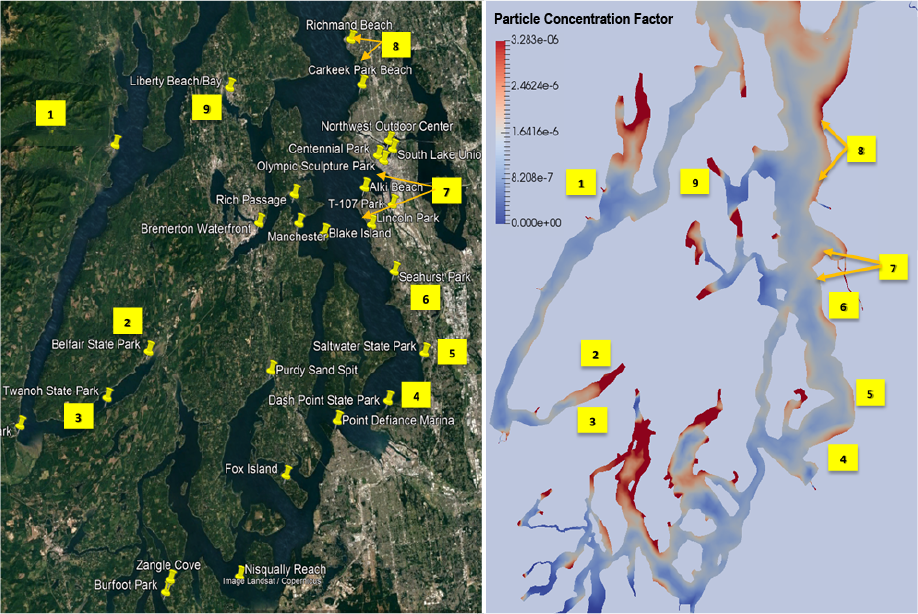Marine Pollution: Microplastic Transport
Simulating Microplastics Transport in the Salish Sea
Increasing levels of microplastic accumulation in the Pacific Northwest has been identified as an emerging issue of concern that has already caused significant damage to the marine ecosystem.

Directly exposed to the Pacific coastline and surrounded by the urbanized communities, the Salish Sea has become vulnerable to the increasing levels of microplastics which are considered as the pieces of plastics with a size less than 5 mm. Despite increased level of awareness in recent years, there is only limited information and data available for exposure assessments associated with microplastics. Of particular interest are (a) identification of the potential sources of marine debris and (b) prediction of the fate, transport, and accumulation of microplastics in the Salish Sea. The Salish Sea consists of numerous interconnected sub-basins and some of them, particularly in the South Puget Sound region have long residence times. The preliminary assessment presented here is a collaborative effort between PNNL and U.S. EPA, in which transport characteristics of microplastics in the Salish Sea were analyzed using a particle tracking model and the hydrodynamic solutions produced by the Salish Sea Model (SSM). This study explores microplastics accumulation features and characteristics in the Salish Sea controlled primarily by bathymetry, shoreline complexity, and tidal circulation.

Several hypothetical scenarios were simulated. A uniform distribution of particles at the water surface was used as the initial condition to represent a uniform loading scenario. Each particle is assumed to represent a cluster of neutrally buoyant micro plastic particles which do not undergo any degradation, sedimentation or coagulation process during the simulation period. A simulation period of two weeks which includes one neap and spring cycle was used. The model predicted the time averaged particle concentration factors (Figure 1) indicate the regions which have high probabilities to trap micro plastic over a certain period. These are regions with the highest residence times for the released particles. Model predictions are qualitatively compared with the regions where the microplastic accumulations were observed during the 2017 Puget Sound Cleanup camp. Model results correctly identified several sites as high particle accumulation sites which have historically shown high levels microplastic accumulation observations. The most notable adverse impact of microplastics infested ocean environment is the accumulations in benthic and pelagic biota (e.g. shellfish) and food chain. The wastewater outfalls could be potential sources of microplastics to the Salish Sea. The Salish Sea receives wastewater from nearly 100 wastewater outfalls.
To examine the impact of microplastics released from outfalls, some scenarios of hypothetical microplastic releases from selected seven major wastewater outfalls located in the Puget sound were studied with relatively low microplastic release rates. Predicted regions with high microplastic accumulation were compared with locations with shellfish beds (figure 2). Data for the regions where the shellfish beds are located and closed due to marine pollution was obtained from information published by Washington State Department of Health. Although, the likely cause for the closures was not necessarily the microplastic accumulation, the model results show the vulnerable regions of shellfish beds for microplastic accumulation are the consistent with sites exposed to marine pollution. Also, it is evident that the weak circulation in Central sound and high resident time of water intensify the accumulations of any pollutant particles (i.e. microplastics, toxics and etc.) released from point sources for a long-term period.

Project Highlights
- Under uniform and instantaneous microplastic loading, the model has been able to predict the regions with high potential of microplastic accumulation. The model predicted regions with high microplastic accumulations include the shore line areas of central and south sounds and the regions with low levels of water circulations.
- The model simulations for continuous microplastic loading from certain major outfalls show, incremental microplastic accumulation over time in the central and southern regions of Puget sound. This could pose a potential threat for the health of shellfish beds stretched over the central and south sounds.
Contacts and Project Team
Study Reports and Publications
Premathilake L, T Khangaonkar. 2019. Preliminary Analysis of Marine Debris Transport in Salish Sea. Memo to U.S. EPA.